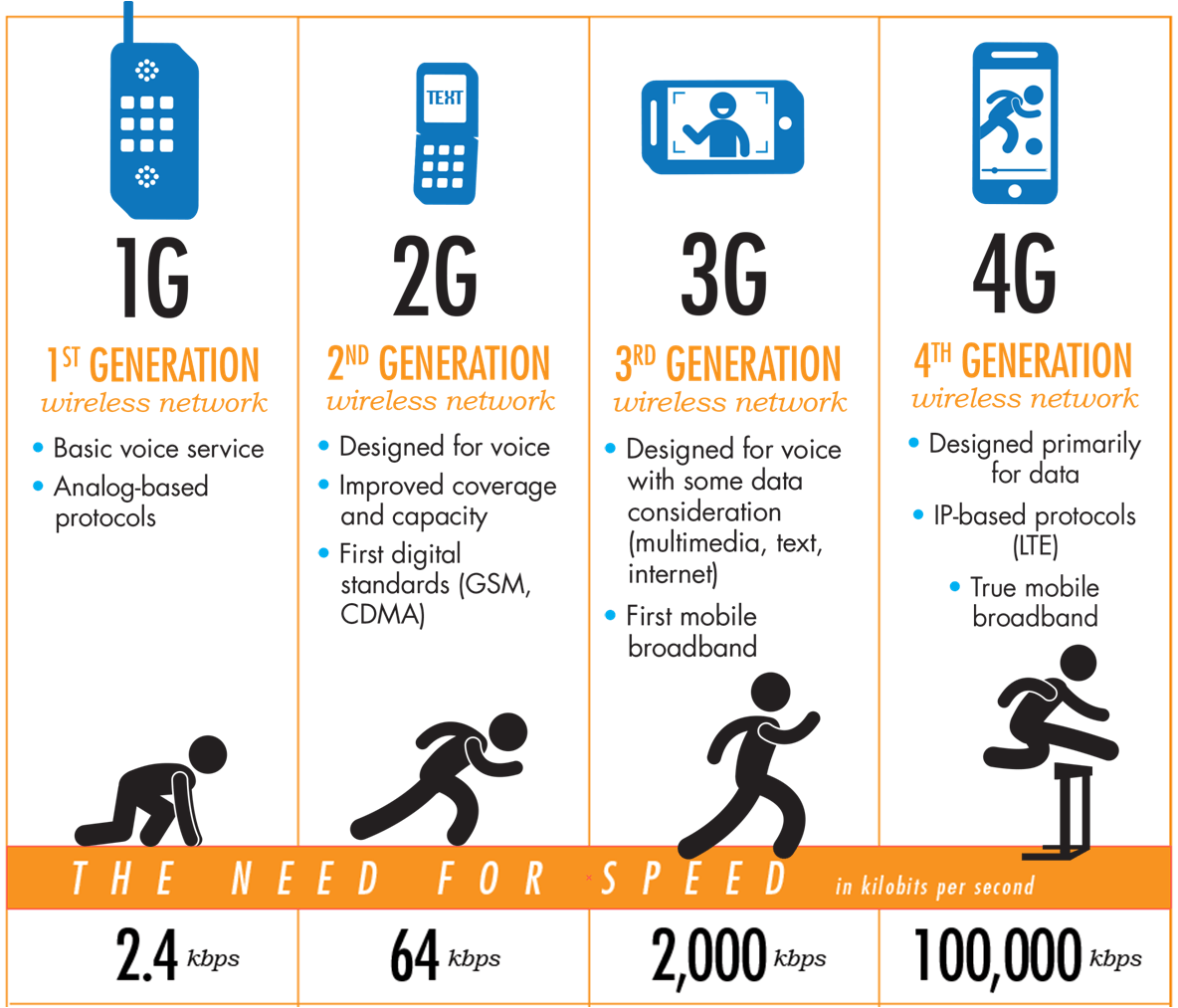Tech Talk : Wireless Network

|
Evolution of Wireless Generations
The "G" in wireless networks refers to the "Generation" of the underlying wireless network technology. Technically, generations are defined as follows.
1G networks (NMT, C-Nets, AMPS, TACS) are considered to be the first analog cellular systems, which started early 1980s. There were radio telephone systems even before that. 1G networks were conceived and designed purely for voice calls with almost no consideration of data services (with the possible exception of built-in modems in some headsets).
2G networks (GSM, CDMAOne, D-AMPS) are the first digital cellular systems launched early 1990s, offering improved sound quality, better security and higher total capacity. GSM supports circuit-switched data (CSD), allowing users to place dial-up data calls digitally, so that the network's switching station receives actual ones and zeroes rather than the screech of an analog modem.
2.5G networks (GPRS, CDMA2000 1x) are the enhanced versions of 2G networks with theoretical data rates up to about 144kbit/s. GPRS offered the first always-on data service.
3G networks (UMTS FDD and TDD, CDMA2000 1x EVDO, CDMA2000 3x, TD-SCDMA, Arib WCDMA, EDGE, IMT-2000 DECT) are newer cellular networks that have data rates of 384kbit/s and more.The UN's International Telecommunications Union IMT-2000 standard requires stationary speeds of 2Mbps and mobile speeds of 384kbps for a "true" 3G.
4G technology refers to the fourth generation of mobile phone communication standards. LTE and WiMAX are marketed as parts of this generation, even though they fall short of the actual standard.
The table below explaing all the generations of wireless networks in greater details
| Gen |
Design |
Implement |
Speed |
Std |
Multiplex |
Core Network |
Feature |
| 1G |
1970 |
1984 |
1 kbps |
NMT, AMPS, TACS |
FDMA |
PSTN |
1G is for analog celluar phones serving only voice signals. |
| 2G |
1980 |
1991 |
9.6/14.4 kbps |
TDMA, CDMA, GSM, PDC |
TDMA, CDMA |
PSTN |
2G capabilities are achieved by allowing multiple users on a single channel via multiplexing. 2G enabled mobile phones can be used for data along with voice communication. |
| 2.5G |
1985 |
1999 |
384 kbps |
GPRS, CDMA2000 1x |
TDMA, CDMA |
PSTN, Packet Network |
Access to roaming across single type of digital wireless networks and across to 1G. |
| 3G |
1999 |
2002 |
3.1 Mbps (peak)
500-700kbps |
CDMA 2000 (1XRTT, EVDO), UMTS, EDGE, WCDMA |
CDMA |
Packet Network |
3G provides excellent internet browsing speeds. Opens the door to a whole bag of opportunities with video calling, video streaming and more. With 3G, it is universally accessible and portable across different device types. |
| 3.5G |
1999 |
2003 |
14.4 Mbps (peak)
1-3 Mbps |
HSPA |
CDMA |
Packet Network |
3.5G supports even higher speed and enhances higher data needs. |
| 4G |
2000 |
2010 |
100-300 Mbps (peak)
3-5 Mbps |
WiMax |
CDMA |
Internet |
Speeds for 4G are increased to lighting fast in order to keep up with data access demand used by various service. It also supports HD video streaming. |
Definition
| Term | | Definition |
| APMS | | Advanced Mobile Phone Service |
| CDMA | | Code Division Multiple Access |
| TDMA | | Time Division Multiple Access |
| GSM | | Global System forMobile Communication |
| PDC | | Personal Digital Celluar |
| W-CDMA | | Wide-band Code Division Multiple Access |
| CDMS-2000 | | Based on Interim Standard-95 CDMA standard |
| TD-SCDMA | | Time-Division Synchronous Code Division Multiple Access |
| Multiplexing | | Multiplexing (sometimes contracted to muxing) is a method by which multiple analog message signals or digital data streams are combined into one signal over a shared medium. |
 Reference
Reference
- The Evolution of Wireless Generations
- 4G VS 3G Networks. Which One will You Prefer?
- 4G technology (Fourth Generation Mobile System)
- Multiplexing
- Wireless System
- 1G, 2G, 3G, 4G: The evolution of wireless generations
- 2G, 3G, 4G, 4G LTE, 5G - What are They?
- What are the differences between 1G, 2G, 3G, 4G and 5G?
- 2G, 3G, 4G, and everything in between: an Engadget wireless primer
|
|

